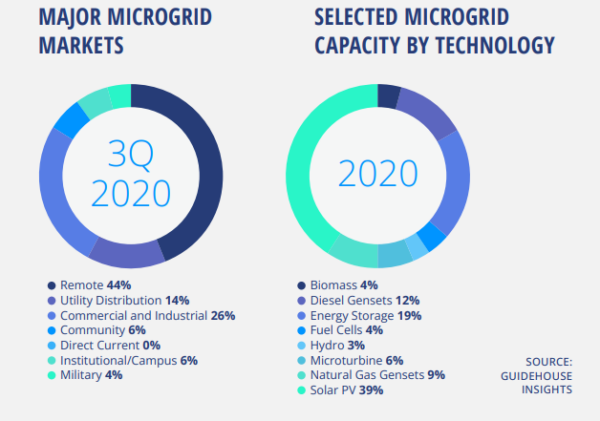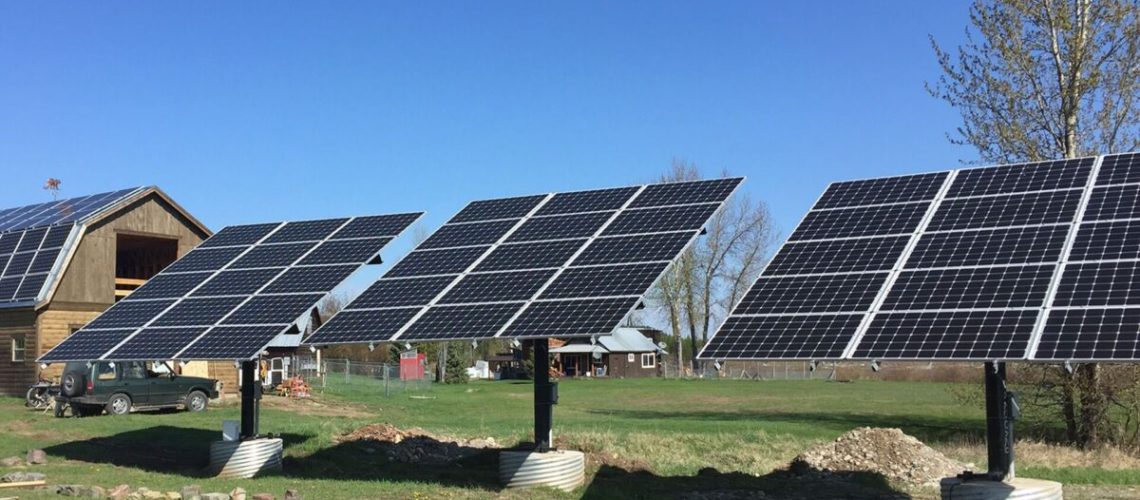Microgrids connect distributed assets like solar, energy storage, and grid-connected electric vehicles to operate a flexible, resilient grid that is able to operate without support from the utility transmission grid.
The U.S. microgrid market is growing steadily, with about 10 GW of microgrid assets deployed through 2022.
According to Wood Mackenzie, the U.S. microgrid market saw a 47% increase in solar and storage capacity additions in 2022 compared to 2017 levels. Moreover, the data shows that more than 175 solar projects and solar-plus-storage microgrids have been in active development and were scheduled to come online by the end of 2022.
From military applications to critical resources, new home communities, remote communities, cities, airports, and universities, microgrids are already providing services to a wide variety of customers that rely on their power supply.
Tailwinds continue to move microgrids along in the U.S. Perhaps most notably the Federal Energy Regulatory Commission (FERC) Order 2222 allow aggregated distributed resources to stand on the same footing as utility-scale assets by participating in the wholesale energy markets.

The asset-based demand response is actively being evaluated across the U.S., including in Texas, which suffered widespread outages in the Winter Storm Uri due to natural gas underperformance and transmission grid restrains. Microgrids offer the ability to quickly respond when communities are hit hard by these constraints under extreme events.
A report from the Netherlands found that microgrid technologies could make a local “technoeconomy” 90% self-sufficient through decentralized energy sharing at the local level between multiple households.
“The climate crisis, however, presents us with an opportunity to rethink our energy systems. There is an urgent need to pivot towards greener, more resilient, and self-sustained energy systems. Not only would this mitigate the impacts of climate change, but it would also enable the infrastructure to effectively handle the power load fluctuations triggered by extreme weather conditions, said the Linux Foundation in a report on the benefits of open source data among the microgrid developer community.
Open source
Open source software is open code published and made available to the public, enabling users to copy, modify, and redistribute code without paying royalties or fees. In the face of a changing climate and increased extreme weather events, open source practices for microgrid operational data may offer an accelerated path towards adoption.
There are five main outcomes the Linux Foundation sees in the practice:
1. EXPANDS ACCESS TO MICROGRIDS, democratizing both energy access in emerging markets and microgrids resources and education for all.
2. ACCELERATES MICROGRID DESIGNS AND TIME-TO-MARKET, by enabling modularity, efficiencies, and open data sharing.
3. IMPROVES INTEROPERABILITY and standards adoption, by fostering ecosystem collaboration, consensus, transparency, and compatibility across the stack.
4. ENABLES MICROGRID BUSINESS MODELS, via software, support and consulting services, training and certification, customization and integration, collaborative partnerships, and advancing modularity.
5. ENABLES MARKET INNOVATION TOWARD ENERGY RESILIENCE AT SCALE, via open source–enabled business models, security, and cost reductions.
The Linux Foundation report includes a series of links to actively available microgrid open source databases, which can be found on page 19. The resources span from standards, modeling and simulation tools, software and platforms, educational resources, associatied foundations, and component and hardware data.
“Some 100 years ago, governments helped scale national power grids with subsidies, but this is not the case with microgrids. They won’t radically scale until we combine forces to bring it all together,” said Manoj Sinha, founder and CEO of Husk. “Yes, it’s a risky bet to publish a roadmap that may divulge your own secret sauce, but we have to do that for the industry to grow. Years ago, when I worked in semiconductors, Intel published a semiconductor roadmap. These roadmaps don’t just help other companies; they help the entire industry pie grow more.”
The collaboration will require participation from microgrid operators, utilities, open source communities and foundations, and governments to fully unlock the potential of this technology.
Microgrid business models
The report examines several of different business models that microgrid providers provide. One popular method in the U.S. is energy-as-a-service (EaaS). Under this arrangement software, remote sensing, analytics, and other technologies enable providers to offer “pay-as-you-go” cloud-based service models for energy with remote monitoring and optimization. The model is particularly popular for U.S. institutional, commercial, and industrial applications, as customers take little to no risk and pay no upfront capital, while the EaaS provider designs, builds, owns, operates, and maintains the microgrid.
Another pathway to microgrids is through a utility partnership with local communities. Under this arrangement, infrastructure and energy management become two separate businesses. Communities benefit from greater efficiencies and reliability, while utilities are able to manage loads, ensuring flexibility and making way for more renewables on the grid.
A third microgrid business model is prosumer and peer-to-peer based microgrids, in which local energy nodes like rooftop solar or grid-connected electric vehicles can sell excess energy to other members of the community or utility, reducing costs for all participants.
“While nascent, these models are creating new tailwinds for microgrid adoption. Meanwhile, several adjacent trends, from standard pricing mechanisms to blockchain tokenization to regulations, could further influence economic incentives for microgrids,” said the Linux Foundation.



